

| 2 Morpho-Phonology | 7a Using Affixes | 12 The Number System | |
| 3 Basic Morphology | 7b Using Affixes (continued) | The Lexicon | |
| 4 Case Morphology | 8 Adjuncts | Revised Ithkuil: Ilaksh |
| 8.1 Personal Reference Adjuncts | 8.4 Affixual Adjuncts |
| 8.2 Subsidiary Adjuncts | 8.5 Alternate Indicators for Vocalic Mutation |
| 8.3 Combination Adjuncts | 8.6 Additional Information on Bias |
The notion of adjuncts was introduced in Section
2.6.2. We have already discussed some details of various kinds of adjuncts:
valence adjuncts and conflation adjuncts were introduced in Secs.
5.2 and 5.4, modality
adjuncts were mentioned in Sec. 5.5,
and aspectual adjuncts were described in Chapter
6. In this chapter, more information is given about these adjuncts and several
additional types of adjuncts are introduced.
The first type of adjunct we will analyze are those relating to personal reference. By “personal reference” is meant the grammatical description of nouns by abbreviated forms of reference. In most languages, this is accomplished by means of personal pronouns (e.g., English he, she, it, I, you, him, her, mine, ours, etc.). Generally, personal pronouns are distinguished by “person” (1st, 2nd , or 3rd) and case (e.g., compare English we, us, and ours). Ithkuil accomplishes the equivalent function by means of personal reference adjuncts, of which there are two types: single-referent and dual-referent.
Like all adjuncts in Ithkuil, personal reference adjuncts are highly synthetic in their structure, comprised of at least two morphemes and usually more. Before we examine the componential structure of personal reference adjuncts themselves, we must first introduce the personal reference categories they refer to.
The morpho-semantic delineations of Ithkuil personal reference categorization are based on inclusion or exclusion in relation to an utterance. These delineations begin with identifying whether or not the party speaking is included or excluded in relation to the utterance. The next delineation made is whether the party being addressed (i.e., the audience/listener) is included or excluded, then finally whether any third party (i.e., a party other than the speaker and the addressee) is included or excluded.
There are 46 personal reference categories in Ithkuil, each
of which is represented by a single consonant affix plus a corresponding falling
or high tone as shown in Table 22 below. The various terms and abbreviations
used in the table are explained following the table.
Table 22(a) and (b): Personal Reference Categories
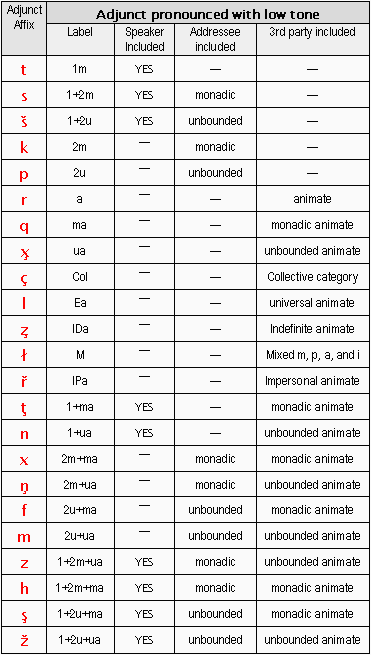 |
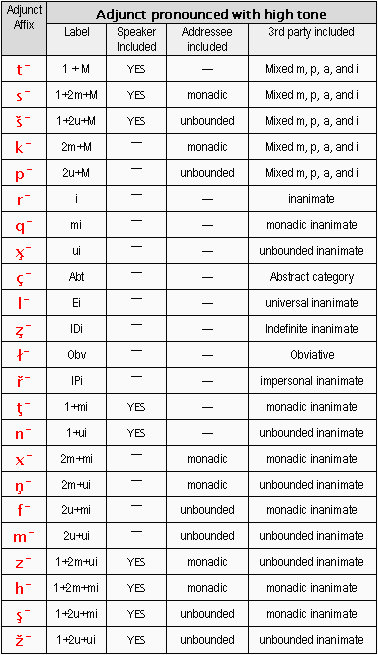 |
Explanation of abbreviations and terms in the above table:
1 = Inclusion of speaker
2 = Inclusion of addressee
m = monadic (single party)
u = unbounded (more than one party)
a = animate 3rd party
i = inanimate 3rd party
E = universal ('everyone/everything')
M = mixed combination of 3rd parties (including animate+inanimate or MONADIC+UNBOUNDED)
IP = Impersonal ('one')
ID = Indefinite ('anyone/anything')
Obv = Obviative (see Sec. 8.1.1.7 below)
Col = Collective (see Sec. 8.1.1.5 below)
Abt = Abstract (see Sec. 8.1.1.6 below)
The following sections explain the terminology in the above table.
8.1.1.1 ![]()
![]() Monadic vs. Unbounded. These terms were discussed in detail in Sec.
3.3 on Perspective. For simplicity’s sake, the difference between
a MONADIC third party versus an UNBOUNDED
third party can be thought of as the difference between ‘he/she/it’
and ‘they.’
Monadic vs. Unbounded. These terms were discussed in detail in Sec.
3.3 on Perspective. For simplicity’s sake, the difference between
a MONADIC third party versus an UNBOUNDED
third party can be thought of as the difference between ‘he/she/it’
and ‘they.’
8.1.1.2 ![]()
![]() Speaker and Addressee. These terms refer respectively to the party
speaking (in Western grammar the first person), the party being spoken to (the
second person), and a third party being considered or mentioned (the third person).
Unlike the standard six-person matrix common in Western grammar (the three persons
divided into singular and plural), Ithkuil divides personal reference along
logical lines of inclusion versus exclusion in the speaker’s utterance.
Speaker and Addressee. These terms refer respectively to the party
speaking (in Western grammar the first person), the party being spoken to (the
second person), and a third party being considered or mentioned (the third person).
Unlike the standard six-person matrix common in Western grammar (the three persons
divided into singular and plural), Ithkuil divides personal reference along
logical lines of inclusion versus exclusion in the speaker’s utterance.
From the viewpoint of Ithkuil grammar, only a single individual can speak. Even if there are two or more persons speaking the same utterance simultaneously it is but a collection of single individuals, each of which is one speaker. Therefore, the “first person” of Ithkuil, the speaker, can be only MONADIC, never UNBOUNDED. Thus, in Ithkuil, there is no true equivalent to the word “we,” since inherent in the various categories which translate “we” is the concept of “I plus some other entity or entities.” From this we can begin to see how it is the idea of inclusion or exclusion in the speaker’s utterance that determines the various personal reference categories.
The “second person” in Ithkuil is the addressee, the person(s) being addressed or spoken to. There can be one addressee, or more than one addressee, i.e., MONADIC or UNBOUNDED.
The “third person” in Ithkuil is where things get very complicated, in that a party being referenced who is not the speaker or the addressee can have many distinctions, including the presence or absence of animacy, being MONADIC versus UNBOUNDED, being referred to as a collective entity, being an intangible abstraction, being indefinite, being an impersonal generic reference, or being a combination of two or more of these categories. These distinctions are explained below.
8.1.1.3 ![]()
![]() Animate vs. Inanimate. This is as it sounds. As we saw in earlier chapters,
particularly Sec. 4.1, several
important morphological categories in Ithkuil are dependent on whether the party
to the act, condition, or event is a living entity or inanimate. Note that the
distinction between gender (he vs. she) found in most Western languages does
not exist in the Ithkuil personal reference system.
Animate vs. Inanimate. This is as it sounds. As we saw in earlier chapters,
particularly Sec. 4.1, several
important morphological categories in Ithkuil are dependent on whether the party
to the act, condition, or event is a living entity or inanimate. Note that the
distinction between gender (he vs. she) found in most Western languages does
not exist in the Ithkuil personal reference system.
8.1.1.4 ![]() “Mixed” Third-Party Reference. It is possible for the third
party being referenced to be two or more entities of different natures. For
example a speaker could make reference to “I, you, and they” where
“they” consists of a group consisting of one person (i.e., a monadic
animate entity), three boxes (i.e., a polyadic inanimate entity), and an intangible
concept such as ‘happiness’ (i.e., an abstract entity). In such
cases, Ithkuil personal reference categories provide for such “mixed”
parties to be included in a particular personal referent.
“Mixed” Third-Party Reference. It is possible for the third
party being referenced to be two or more entities of different natures. For
example a speaker could make reference to “I, you, and they” where
“they” consists of a group consisting of one person (i.e., a monadic
animate entity), three boxes (i.e., a polyadic inanimate entity), and an intangible
concept such as ‘happiness’ (i.e., an abstract entity). In such
cases, Ithkuil personal reference categories provide for such “mixed”
parties to be included in a particular personal referent.
8.1.1.5 ![]() Collective Reference. This corresponds to the NOMIC
Perspective in which a noun can be spoken of as a generic collective. For example,
the word ‘dog’ in the sentence The dog is a noble beast
refers to all dogs in a collective sense, not any dog in particular. This COLLECTIVE
category has its own set of personal reference affixes in Ithkuil, depending
on what other entities are included in the context of the utterance.
Collective Reference. This corresponds to the NOMIC
Perspective in which a noun can be spoken of as a generic collective. For example,
the word ‘dog’ in the sentence The dog is a noble beast
refers to all dogs in a collective sense, not any dog in particular. This COLLECTIVE
category has its own set of personal reference affixes in Ithkuil, depending
on what other entities are included in the context of the utterance.
8.1.1.6 ![]() Abstract Reference. This corresponds to the ABSTRACT
perspective, equivalent to derivational abstract forms such as English nouns
ending with -hood, -ness, etc. In Ithkuil, all nouns can be
spoken of in this abstract sense (e.g., “bookhood” = the
sense of being or functioning as a book), and the personal reference system
provides affixes for this category whose form again depends on what other entities
are included in the context of the utterance.
Abstract Reference. This corresponds to the ABSTRACT
perspective, equivalent to derivational abstract forms such as English nouns
ending with -hood, -ness, etc. In Ithkuil, all nouns can be
spoken of in this abstract sense (e.g., “bookhood” = the
sense of being or functioning as a book), and the personal reference system
provides affixes for this category whose form again depends on what other entities
are included in the context of the utterance.
8.1.1.7 ![]() Obviative (4th Person) Reference. This category has no equivalent in
Western languages, although it is found in various Native American languages.
It refers to a third party referent other than one previously mentioned, which
would otherwise be identically marked. In Native American grammatical treatises,
this category is usually termed the obviative or “fourth” person.
For example, the English sentence He saw his book is ambiguous because
we are uncertain whether ‘he’ and ‘his’ refer to the
same person or to two different persons (i.e., one who did the seeing and another
who owns the book). In Ithkuil, no such ambiguity occurs because the latter
third person referent, if a distinct person from the initial third person referent,
would be marked using the OBVIATIVE, not the third person.
This disambiguation of third person referents is the purpose of the OBVIATIVE.
Its translation into English is therefore dependent on a preceding personal
referent. (See Sec. 8.1.4 below for more information
about the OBVIATIVE).
Obviative (4th Person) Reference. This category has no equivalent in
Western languages, although it is found in various Native American languages.
It refers to a third party referent other than one previously mentioned, which
would otherwise be identically marked. In Native American grammatical treatises,
this category is usually termed the obviative or “fourth” person.
For example, the English sentence He saw his book is ambiguous because
we are uncertain whether ‘he’ and ‘his’ refer to the
same person or to two different persons (i.e., one who did the seeing and another
who owns the book). In Ithkuil, no such ambiguity occurs because the latter
third person referent, if a distinct person from the initial third person referent,
would be marked using the OBVIATIVE, not the third person.
This disambiguation of third person referents is the purpose of the OBVIATIVE.
Its translation into English is therefore dependent on a preceding personal
referent. (See Sec. 8.1.4 below for more information
about the OBVIATIVE).
8.1.1.8 ![]() Indefinite Reference. This category indicates that the third party
refers to any third party within the specified parameters. For example, the
referent
Indefinite Reference. This category indicates that the third party
refers to any third party within the specified parameters. For example, the
referent ![]() indicates an indefinite animate party, i.e., English ‘anyone’ or
‘anybody,’ while the referent
indicates an indefinite animate party, i.e., English ‘anyone’ or
‘anybody,’ while the referent ![]() indicates an indefinite inanimate party, i.e., English ‘anything.’
indicates an indefinite inanimate party, i.e., English ‘anything.’
8.1.1.9 ![]() Universal Reference. This category indicates that the third party refers
to every third party within the specified parameters. For example, the referent
-l
Universal Reference. This category indicates that the third party refers
to every third party within the specified parameters. For example, the referent
-l ![]() indicates a universal animate party, i.e., English ‘everyone’ or
‘everybody,’ while the referent -l¯
indicates a universal animate party, i.e., English ‘everyone’ or
‘everybody,’ while the referent -l¯
![]() indicates a universal inanimate party, i.e., English ‘everything.’
indicates a universal inanimate party, i.e., English ‘everything.’
8.1.1.10 ![]() Impersonal Reference. This category corresponds to the German pronoun
man or French pronoun on, as well as the various circumlocutions
used in English to describe impersonal reference (e.g., ‘one,’ ‘you,’
‘they,’ the passive voice, and certain usages of ‘someone’).
Such impersonal reference is illustrated in the following English sentences:
Impersonal Reference. This category corresponds to the German pronoun
man or French pronoun on, as well as the various circumlocutions
used in English to describe impersonal reference (e.g., ‘one,’ ‘you,’
‘they,’ the passive voice, and certain usages of ‘someone’).
Such impersonal reference is illustrated in the following English sentences:
· One should never speak to clowns alone.
· To dance the tango you need a partner.
· They say it never rains in August.
· That town is said to be haunted.
· She just wants to talk to someone without being criticized.
8.1.1.11 Inclusivity vs. Exclusivity. Since Ithkuil personal reference adjuncts are designed to specify who among the speaker, addressee(s), and any third party is included or excluded in the context of the utterance, there are many possible personal reference distinctions possible in Ithkuil for which English has no equivalent pronouns. Such exacting distinctions would have to be made periphrastically in English, e.g., instead of saying ‘we,’ the speaker would have to specify ‘the two of us,’ or ‘I and he but not you,’ or ‘I, you, and they.’ Similarly, the English word ‘you’ breaks down into specific meanings equivalent to ‘you (singular),’ ‘you (plural),’ ‘you (singular) and it,’ ‘you and those people,’ ‘you and those things,’ etc.
Adjuncts with one personal referent are termed single-referent
adjuncts and have three forms: (1) a short form, (2) a long form, and (3) a
conjunct form, as shown in Table 23 below.
Table 23:
Morphological Structure of a Single-R![]() eferent Personal Reference Adjunct
eferent Personal Reference Adjunct
| Form 1: |
Example: | ||||||||||||||||||||||||
| Form 2: |
Examples: |
||||||||||||||||||||||||
| Form 3: |
Example: |
||||||||||||||||||||||||
|
|||||||||||||||||||||||||
The short form of the adjunct consists of a single consonant
(labeled CR in the diagram) plus tone,
corresponding to one of the 46 particular referents (as described in Sec.
8.1.1 above). This is followed by a single vocalic suffix VC
indicating the case of the personal referent (see Chapter 4 on Case). The 81
possible values for this suffix are shown in Table 24 below.
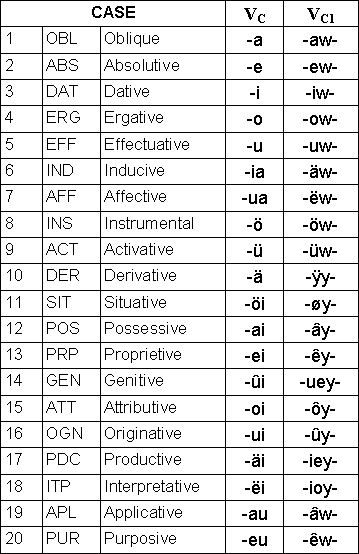 |
|
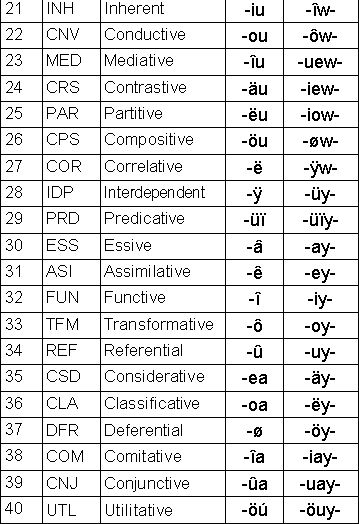 |
|
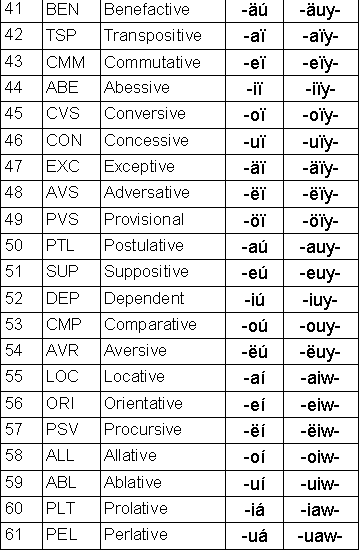 |
|
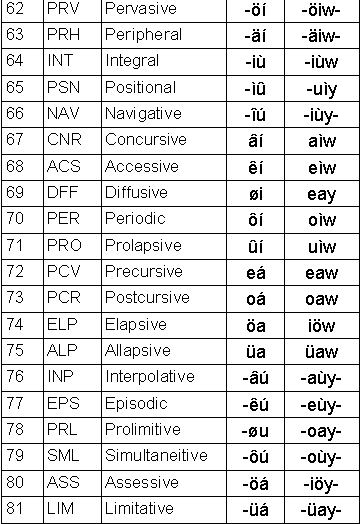 |
As for the long form of the adjunct, the first part is an optional
vocalic prefix ![]() which indicates the Configuration, Affiliation, and Designation of the personal
referent (see Chapter 3
for a discussion of these morphological categories). The possible values for
which indicates the Configuration, Affiliation, and Designation of the personal
referent (see Chapter 3
for a discussion of these morphological categories). The possible values for
![]() are shown in Tables 25(a) and (b) below.
are shown in Tables 25(a) and (b) below.
Table 25(a) and (b): ![]() Prefixes
for Single-Referent Personal Reference Adjuncts
Prefixes
for Single-Referent Personal Reference Adjuncts
25(a) Designation
of Referent 1 = INFORMAL
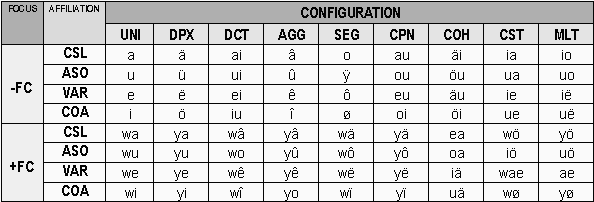
25(b) Designation
of Referent 1 = FORMAL

The second part of the long form of the adjunct is the single consonant (![]() )
plus tone shown previously in Table 22, corresponding
to the personal referent. The third part of the long form of the adjunct is
a syllabic infix (
)
plus tone shown previously in Table 22, corresponding
to the personal referent. The third part of the long form of the adjunct is
a syllabic infix (![]() )
which shows the case of the personal referent; it is a combination of a vowel
or diphthong followed by the consonant y or w.
The 81 possible values for this
)
which shows the case of the personal referent; it is a combination of a vowel
or diphthong followed by the consonant y or w.
The 81 possible values for this ![]() infix are shown in the last column of Table 24 above.
The final term of the long form of the adjunct is a single vowel suffix -
infix are shown in the last column of Table 24 above.
The final term of the long form of the adjunct is a single vowel suffix -![]() which, in conjunction with syllabic stress, indicates the Context of the personal
referenct (see Sec.
3.6 on Context). The four values for this -
which, in conjunction with syllabic stress, indicates the Context of the personal
referenct (see Sec.
3.6 on Context). The four values for this -![]() suffix are shown in Table 23 above.
suffix are shown in Table 23 above.
As for the third type, or conjunct form of the adjunct, the
first three terms of are identical to those of the long-form. The new terms
are ![]() ,
which is merely a standard suffix used with formatives, as analyzed in Sec.
7.7, and a vocalic infix,
,
which is merely a standard suffix used with formatives, as analyzed in Sec.
7.7, and a vocalic infix, ![]() ,
which indicates the degree of
,
which indicates the degree of ![]() .
The values of
.
The values of ![]() are shown in Table 26 below. The affix-type
are shown in Table 26 below. The affix-type ![]() of is shown by the adjunct’s stress pattern. Optional terms are
of is shown by the adjunct’s stress pattern. Optional terms are ![]() ,
one of four vocalic suffixes showing the Context of the personal referent, and
,
one of four vocalic suffixes showing the Context of the personal referent, and
![]() ,
a consonantal bias affix previously introduced in Sec.
6.6. The use of
,
a consonantal bias affix previously introduced in Sec.
6.6. The use of ![]() is optional if the context of the referent is already known (or can be inferred)
from the utterance. The appearance of the
is optional if the context of the referent is already known (or can be inferred)
from the utterance. The appearance of the ![]() bias suffix is dependent on the appearance of
bias suffix is dependent on the appearance of ![]() ,
i.e.,
,
i.e., ![]() must appear if
must appear if ![]() is to appear, although
is to appear, although ![]() can appear in word-final position without any
can appear in word-final position without any ![]() bias suffix.
bias suffix.
|
For all three forms of the adjunct, shift from falling to broken tone, or from high to rising, indicates the REPRESENTATIVE essence of the personal referent.
8.1.2.1 Use of the Short Form. The short form of a single-referent personal reference adjunct is used when it is clear from the surrounding context of the utterance which previously identified noun participant is being referred to, so that it is unnecessary to indicate the Configuration, Affiliation, Designation, Focus, and Context of the referent. The short form of the adjunct merely indicates the party itself and its case.
8.1.2.2 Use of the Long Form: The long form of the adjunct is used when necessary to indicate the context and/or the Configuration, Affiliation, Designation, and Focus of the referent when the surrounding sentences do not provide or make clear this information.
8.1.2.3 Use of the Conjunct Form: Form 3 of
the adjunct, the conjunct form, is a single-referent adjunct which combines
with a standard formative affix, allowing an affix category to be applied to
a personal referent, just as an affix category would normally apply to the formative
to which it is affixed. This allows personal referents to be spoken of in contexts
created by affix categories, such as when combining -V1![]() /7
‘there (by addressee)’ with paw(a)
/7
‘there (by addressee)’ with paw(a)
![]() to give the form pawo
to give the form pawo![]() meaning ‘you people there.’
meaning ‘you people there.’
_Listen!
Ithkuil allows a personal reference adjunct to show the personal reference category and associated case for two separate parties all in one adjunct. This is called a dual-referent adjunct and serves to combine two unrelated personal referents into one adjunct, no matter what their associated cases may be. There is only one form of a dual-referent adjunct, shown in Table 27 below.
Table 27: Morphological Structure
of a Dual-Referent Personal Reference Adjunct
| Form 3: |
Examples: p’awik |
||||||||||||||||||||
|
|||||||||||||||||||||
![]() represents the same optional vocalic prefix as used with single-referent adjuncts
(see Section 8.1.2) and is used to give Configuration,
Affiliation, Focus, and Designation information about the first referent, Referent-1;
the values for
represents the same optional vocalic prefix as used with single-referent adjuncts
(see Section 8.1.2) and is used to give Configuration,
Affiliation, Focus, and Designation information about the first referent, Referent-1;
the values for ![]() when Referent-1 is in the NORMAL essence are as shown in Tables
25(a) and (b). For dual-referent adjuncts where the essence of Referent-1
is the REPRESENTATIVE, the values for
when Referent-1 is in the NORMAL essence are as shown in Tables
25(a) and (b). For dual-referent adjuncts where the essence of Referent-1
is the REPRESENTATIVE, the values for ![]() are given in the Tables 28(a) and (b)below.
are given in the Tables 28(a) and (b)below.
Table 28(a) - (b): ![]() Prefixes for Dual-Referent Pers. Ref. Adjuncts
Prefixes for Dual-Referent Pers. Ref. Adjuncts
_______________( Where Essence of
Referent-1 = RPV)
28(a) Designation
of Referent 1 = INFORMAL
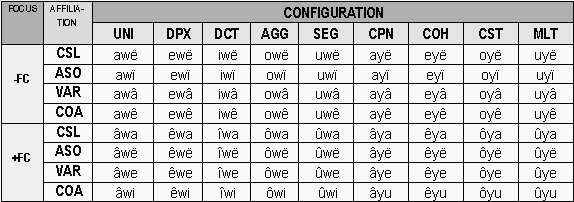
28(b) Designation
of Referent 1 = FORMAL
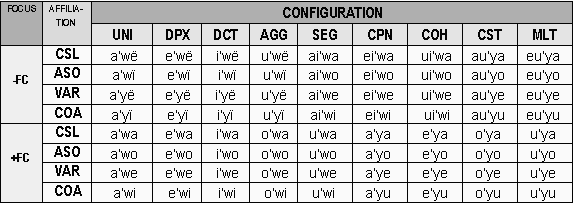
|
DESIGNATION |
CONTEXT |
|
-FR INFORMAL |
EXS |
a |
FNC |
e |
|
RPS |
o |
|
AMG |
ä |
|
+FR FORMAL |
EXS |
ï |
FNC |
i/u |
|
RPS |
ë |
|
AMG |
ü |
![]() is a vocalic suffix indicating the Context and Designation of Referent-2; its
values are shown in Table 29 immediately above. The composite prefix (labeled
is a vocalic suffix indicating the Context and Designation of Referent-2; its
values are shown in Table 29 immediately above. The composite prefix (labeled
![]() )
is a synthetic consonantal prefix formed from the combination of the Referent-1
prefix and the Referent-2 prefix. For example, the combination of the prefix
s- with the
prefix f-
renders the composite prefix sf-,
while the combination of the prefix t-
with the prefix q-
gives the composite t’-.
Table 30 below illustrates how the 23 single-consonant prefixes combine with
each other.
)
is a synthetic consonantal prefix formed from the combination of the Referent-1
prefix and the Referent-2 prefix. For example, the combination of the prefix
s- with the
prefix f-
renders the composite prefix sf-,
while the combination of the prefix t-
with the prefix q-
gives the composite t’-.
Table 30 below illustrates how the 23 single-consonant prefixes combine with
each other.
Table 30: Personal Reference
Adjunct Prefixes
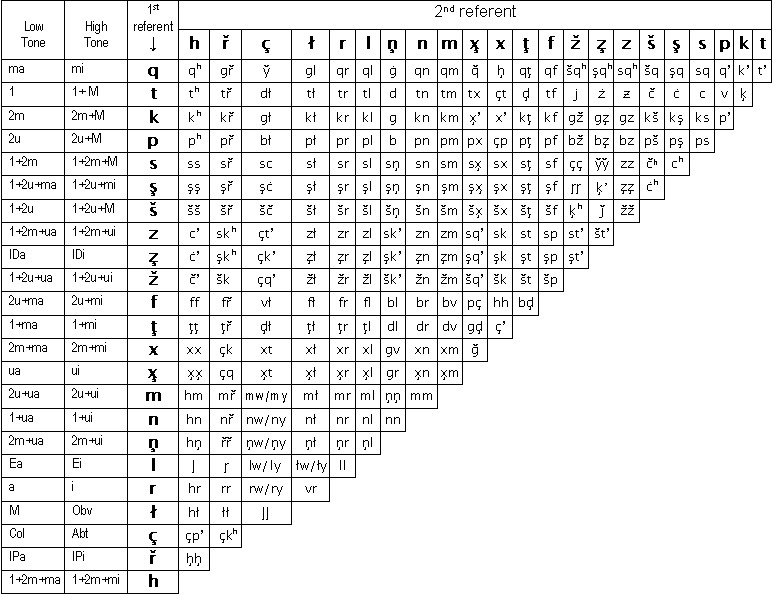
Explanation of abbreviations and terms in the above table:
1 = Inclusion of speaker
2 = Inclusion of addressee
m = monadic (single party)
u = unbounded (more than one party)
a = animate 3rd party
i = inanimate 3rd party
E = universal ('everyone/everything')
M = mixed combination of 3rd parties (including animate+inanimate or MONADIC+UNBOUNDED)
IP = Impersonal ('one')
ID = Indefinite ('anyone/anything')
Obv = Obviative (see Sec. 8.1.1.7 below)
Col = Collective (see Sec. 8.1.1.5 below)
Abt = Abstract (see Sec. 8.1.1.6 below)
Note that when combining two referent prefixes to form the
composite ![]() prefix the tones associated with each referent must also be combined (remember
it is the distinction between low and high tone that expands the 23 single-consonant
referents into 46). Since all single-referent adjuncts are either of falling
or high tone, their combination proceeds as follows:
prefix the tones associated with each referent must also be combined (remember
it is the distinction between low and high tone that expands the 23 single-consonant
referents into 46). Since all single-referent adjuncts are either of falling
or high tone, their combination proceeds as follows:
falling + falling
falling
high + highhigh
falling + highrising
high + fallingbroken
As for the Referent-1 case infix, this is the same vocalic case-affix (VC1) we saw for single-referent adjuncts in Sec. 8.1.2 above (with the vocalic increment ending in -y- or -w-). The forms for these case infixes were given in Table 24.
Deferring for a moment the explanation of the Referent-2 consonantal
case suffix (![]() ),
the last two terms of the dual-referent adjunct are
),
the last two terms of the dual-referent adjunct are ![]() and
and ![]() .
The former is one of four vocalic affixes representing the affiliation of Referent-2,
while the latter is the consonantal bias affix previously introduced in Sec.
6.6. The use of
.
The former is one of four vocalic affixes representing the affiliation of Referent-2,
while the latter is the consonantal bias affix previously introduced in Sec.
6.6. The use of ![]() is optional if the affiliation of the referent is already known (or can be inferred)
from the context of the utterance. The appearance of the
is optional if the affiliation of the referent is already known (or can be inferred)
from the context of the utterance. The appearance of the ![]() bias suffix is dependent on the appearance of
bias suffix is dependent on the appearance of ![]() ,
i.e.,
,
i.e., ![]() must appear if
must appear if ![]() is to appear, although
is to appear, although ![]() can appear in word-final position without any
can appear in word-final position without any ![]() bias suffix.
bias suffix.
The four-way combination of Essence and Focus for Referent-2 is shown by the four available stress patterns: penultimate stress indicates NORMAL + UNFOCUSED, ultimate stress indicates NORMAL + FOCUSED, antepenultimate indicates REPRESENTATIVE + UNFOCUSED, and preantepenultimate indicates REPRESENTATIVE + FOCUSED. (See Sec. 3.8 on Essence, and Sec. 3.5 on Focus.)
The Referent-2 consonantal case suffix (![]() )
is a consonantal suffix associated with each of the 81 noun cases. Note that
each of these case-frame adjunct markers has nine forms (a default form and
eight mutations). These nine variants are used to indicate the configuration
of Referent-2 (see Sec.
3.1 on Configuration). The values for are shown in Tables 31 below.
)
is a consonantal suffix associated with each of the 81 noun cases. Note that
each of these case-frame adjunct markers has nine forms (a default form and
eight mutations). These nine variants are used to indicate the configuration
of Referent-2 (see Sec.
3.1 on Configuration). The values for are shown in Tables 31 below.
Table 31: ![]() Suffixes for Dual-Referent Personal Reference Adjuncts
Suffixes for Dual-Referent Personal Reference Adjuncts
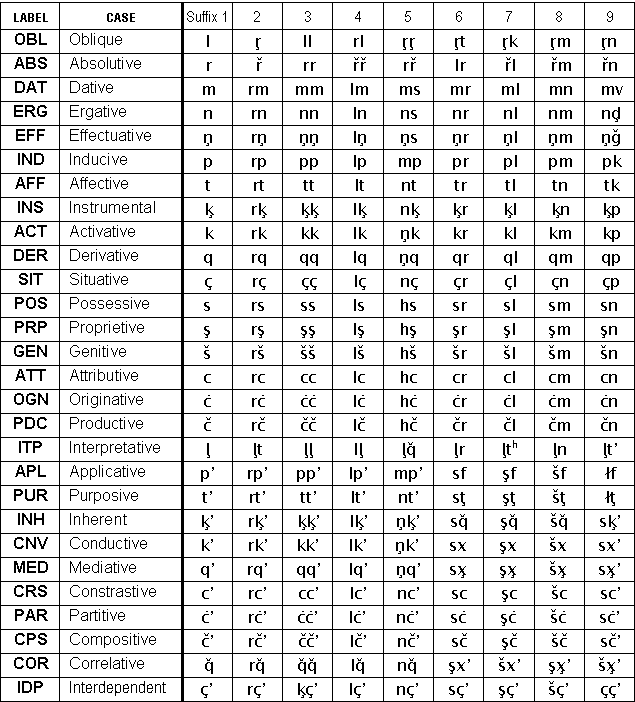 |
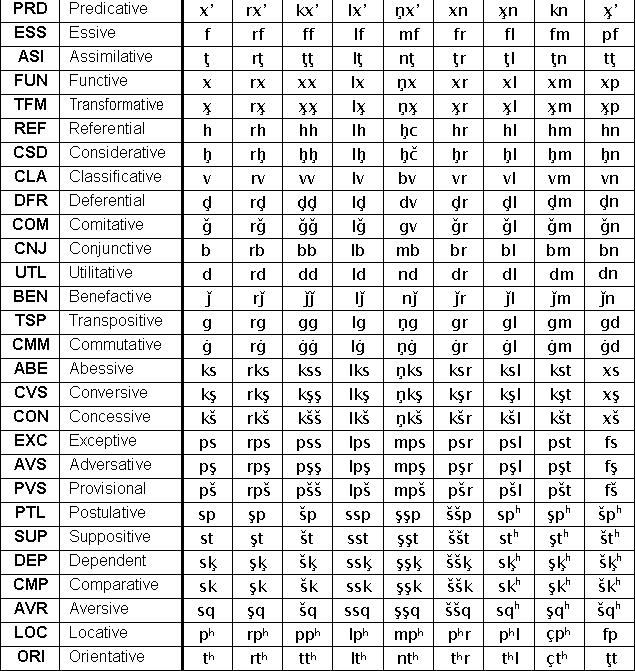 |
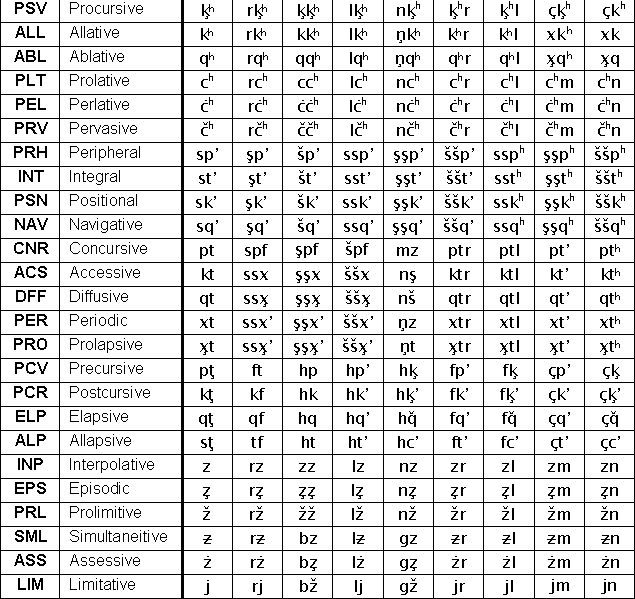 |
8.1.3.1 Special Use of Short Adjunct Form. The short form of
the single-referent adjunct discussed in Sec. 8.1.2
above (utilizing the abbreviated ![]() suffix from Table 24) can be used with the special dual-referent
suffix from Table 24) can be used with the special dual-referent
![]() composite prefixes from Table 30 under the following
circumstance: to show that two different parties are governed by the same case
and participate equally with the verb, equivalent to connecting two pronouns
in English by ‘and’ as in He and I went to the store or
The man looked at them and me. Examples: ksau¯,
xnû,
hhea
composite prefixes from Table 30 under the following
circumstance: to show that two different parties are governed by the same case
and participate equally with the verb, equivalent to connecting two pronouns
in English by ‘and’ as in He and I went to the store or
The man looked at them and me. Examples: ksau¯,
xnû,
hhea![]() .
Note in the last example hhea
.
Note in the last example hhea![]() how the combination of a low-toned referent and a high-toned referent combines
to give a rising-toned adjunct.
how the combination of a low-toned referent and a high-toned referent combines
to give a rising-toned adjunct.
8.1.3.2 Illustration of a Dual-Referent Adjunct:
Based on the above information, we can now analyze an example dual-referent
adjunct — diawàsmûç![]() :
:
| (
)- |
= |
INFORMAL designation, UNIPLEX configuration, CONSOLIDATIVE affiliation, NORMAL essence and negative FOCUS for Referent No. 1 |
-d |
= |
combination of Referent No. 1, t-
|
-iaw- |
= |
PROLATIVE case infix (meaning “along [the surface of] X”) for Referent No. 1 |
-a- |
= |
INFORMAL designation and EXISTENTIAL context for Referent No. 2 |
-sm- |
= |
POSSESSIVE case and MULTIFORM configuration for Referent No. 2 |
-û- |
= |
VARIATIVE affiliation for Referent No. 2 |
-ç |
= |
REACTIVE bias |
[stress] |
= |
ultimate stress indicating NORMAL essence and positive FOCUS for Referent No. 2 |
Approximate translation: over me [= along my body] + what belongs to a rag-tag amalgamation of you (singular) and all those things + [sense of surprise].
While such a word might seem contrived at first, it nevertheless proves quite functional in a sentence such as the following (which a Star Trek© character might say to a Borg after the latter has produced an “assimilated” spider from its pocket and let it loose during the night):
Other examples of the use of dual-referent personal reference adjuncts are given below.
In Section 7.7.13, the SWR switch reference suffix was introduced. This affix works with the OBVIATIVE personal referent (see Sec. 8.1.1.7) to specifically indicate which party is being referred to. The following is a review of this affix for all nine degrees. By use of this affix, reference can be made immediately to any party relevant to a discourse, even to a third party not previously mentioned.
| -V2_’ | SWR |
Switch Reference & Obviative Specification |
| Degree 1 | nearest preceding referent | |
| Degree 2 | 2nd to nearest preceding referent | |
| Degree 3 | 3rd party not previously mentioned | |
| Degree 4 | referring to sentence focus | |
| Degree 5 | first referent mentioned | |
| Degree 6 | referring to sentence topic | |
| Degree 7 | 3rd party non-transrelative referent | |
| Degree 8 | 2nd order transrelative referent | |
| Degree 9 | higher order transrelative referent | |
The following example illustrates the use of the switch reference suffix:
Sec. 7.4 described the existence of a special group of specialized suffixes derived from personal reference adjunct consonantal infixes. As previously discussed in Sec. 8.1.1, there are 23 single consonants associated with 46 single-referent personal reference categories (based on a distinction between low and high tone). These 23 consonants can be combined with Type 3 vocalic infix patterns (see Sec. 2.7.2) to correspond to certain Associative and Appositive noun cases. The low versus high tone distinction for these 23 consonants (from which the 46 categories are derived) is shown by distinguishing between the V+C standard form of the suffix and its reversed C+V form (see Sec. 7.5.2 on the “reversed” form of suffixes). Unlike other -V3C suffixes, there are no -V1C or -V2C counterparts to these suffixes (or rather, the -V1C or -V2C counterparts have completely different meanings and uses). The use of these suffixes is optional, since they are merely substitutes for single-referent personal reference adjuncts. The noun cases associated with the nine suffix degrees are as follows:
| Degree 1 | POSSESSIVE Case | |
| Degree 2 | PROPRIETIVE Case | |
| Degree 3 | GENITIVE Case | |
| Degree 4 | ATTRIBUTIVE Case | |
| Degree 5 | ORIGINATIVE Case | |
| Degree 6 | PRODUCTIVE Case | |
| Degree 7 | INTERPRETATIVE Case | |
| Degree 8 | INHERENT Case | |
| Degree 9 | CONDUCTIVE Case | |
Examples of Use:
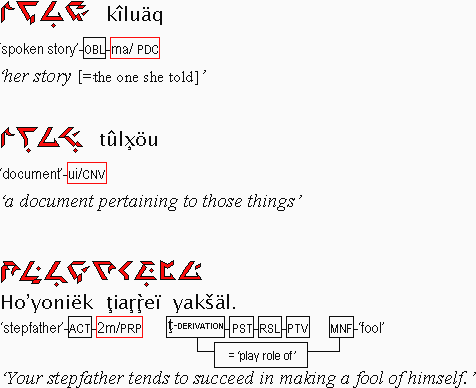
Subsidiary adjuncts refer to adjuncts which are essentially
subsets or “pieces” of the conflation adjunct first introduced in
Chapter 5. Conflation adjuncts comprise the morphological categories of Derivation,
Valence, Version, Format, Modality and Level, and are of the form CN
+ VV + CK + Vm [+ tone], exemplified by the word t’uillia¯
= t’+ui+ll+ia+¯.
However, it is possible to take this same adjunct and present only select portions
of it. We already saw this in Sec. 5.2 when we were introduced to valence adjuncts,
which are essentially composed of the VV + CK “subset” of a conflation
adjunct. Similarly we can have simple modality adjuncts of the form Vm
[+ tone] as in the word ia¯ which also shows
the category of Level (via the tone indication). A simple format adjunct is
possible by simply using CK by itself as a word, e.g., ll.
To this can be added the Vm [+ tone] increment to provide a
subsidiary adjunct showing Format, Modality and Level, as in llia¯.
Combination adjuncts refer to adjuncts which start with an autonomous consonantal form indicating Mood (see Sec. 6.5), then add on various morphological categories other than those combinations seen in conflation, subsidiary, and aspectual adjuncts. The use combination adjuncts is optional, determined primarily by euphonic (i.e., phonotactical and phonaesthetic) concerns in order to decrease the number of syllables which a formative might otherwise have due to multiple affixation and mutation of its phonemes. The various combination adjunct structures are de-tailed in the sections below.
The most basic combination adjunct combines Aspect with Mood.
In this adjunct, Mood is indicated by an initial w-
or y- plus
tone (the tone pattern is shown in Table 32 below). This is followed by one
of the 32 aspect suffixes from Table
19 in Sec. 6.4.1. Examples: wea¯,
yaï![]() .
Note that, in the absence of an aspectual adjunct (which normally shows mood),
this simple element can function by itself as a mood adjunct
by simply using the neutral -VS suffix,
e.g., wa,
ya¯.
.
Note that, in the absence of an aspectual adjunct (which normally shows mood),
this simple element can function by itself as a mood adjunct
by simply using the neutral -VS suffix,
e.g., wa,
ya¯.

This combination adjunct has the form Vj + w/y + VF (+Cb) + [tone & stress], where:
| Vj |
= |
an initial vowel indicating either one
of the nine phases or one of the nine validations, as shown in Table 33
below; a following -w- infix indicates that Vj
shows Phase, while a following -y- infix indicates Vj
shows Validation |
| VF |
= |
a vowel form indicating one of eight Formats and
four Levels (see Sec. 5.6),
as shown in Table 34 below |
| Cb |
= |
one of the 48 optional Bias affixes from Table
20 in Sec. 6.6 |
| tone+
stress |
= |
The combination of four tones with ultimate versus
antepenultimate stress signifies one of the eight moods, consistent with
the tone/stress pattern for mood used with aspectual adjuncts, as described
in Section 6.5 |
Example: oweiç![]() .
.
Table 33: Vj
Format + Level Vocalic Infixes for Combination Adjuncts
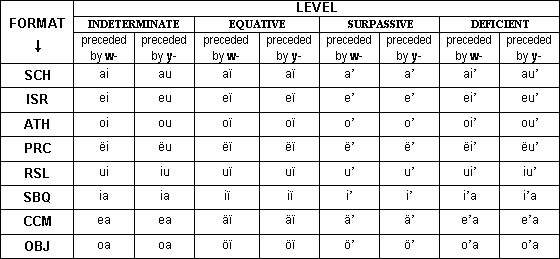
This combination adjunct is structured identically to the immediately preceding adjunct form except that the adjunct adds a word-initial affix (one of the consonantal affix forms from Sec. 7.7) and Vj now indicates one of the nine affix-degrees associated with this affix. Additionally, the first three forms of the Format/Focus infix from Table 33 above are now used to indicate affix-type instead of Level. Examples: psiyoul, juwä’mm.
Any single formative affix, or any two such affixes, may be
removed from the formative and positioned as an adjacent adjunct for purposes
of euphony. Additionally, since affix categories represent common concepts generally
applicable to many contexts, an affixual adjunct can also be informally used
as a “short cut” method of conveying a notion, essentially as an
abbreviated one-word sentence somewhat like an interjection or exclamation in
English, thus conveying the concept of the affix category. For example, the
affix -V1![]() /7
connotes disappointing typicality, but as an affixual adjunct,
/7
connotes disappointing typicality, but as an affixual adjunct, ![]() ï.’a,
it can be used by itself as an informal expression translatable by the English
phrase How typical!
ï.’a,
it can be used by itself as an informal expression translatable by the English
phrase How typical!
The form of a single-affix affixual adjunct is CV’a,
where CV represents the word-final
“reversed” form of a standard suffix for formatives from Sec.
7.7 (see Secs. 2.7.2
and 7.5.2 on the alternate
“reversed” forms of suffixes). So, for example, the suffix -eu![]() ’/
’/![]() ’iu
(i.e., -V2
’iu
(i.e., -V2![]() ’/4)
becomes the autonomous word
’/4)
becomes the autonomous word ![]() ’iu’a,
meaning ‘scattered all around here.’
’iu’a,
meaning ‘scattered all around here.’
The form for a dual-affix affixual adjunct is CV’’VC, where the first part, CV, is the same reversed form of a standard suffix as for the single-affix adjunct above. The second part, VC, represents the “normal,” unreversed form of a standard suffix. When pronouncing such an adjunct, it is important to geminate (i.e., double) the glottal stop, so as not to confuse the word with a simple formative in Secondary Mode, Series B vowel mutation (see Sec. 2.5). So, combining the two suffixes -V2v/7 and -V1kt/9 would give the adjunct vë’’ukt, meaning ‘probably this one.’
Using stress and tone, it becomes possible to combine Mood with both single- and dual-affix affixual adjuncts (with the exception of the default FACTUAL mood which is unmarked). Because the standard forms for both types of affixual adjuncts have at least two syllables, the regular indicators for Mood used with aspectual adjuncts as described in Sec. 6.5 (four tones + two stress patterns = 8 moods) can be applied to affixual adjuncts as well.
In looking at the tables in Sec.
2.5, one can see that several vocalic mutational series cause an additional
syllable to be added to a formative (e.g., kad
![]() ka’wed).
For phonaesthetic purposes (see Sec.
1.4.5), it may become desirable to eliminate this extra syllable in the
formative by indicating the vocalic mutation series elsewhere. Ithkuil allows
this to be done by using word-initial vocalic prefixes to certain adjuncts as
an alternate way of indicating the vocalic mutation series of an adjacent formative.
As a result, the formative itself displays the default Series A form. The two
types of adjuncts which can take such prefixes are affixual adjuncts (both single-
and dual-affix types) and conflation adjuncts. The specific prefixes used with
the adjunct are shown in Table 34 below.
ka’wed).
For phonaesthetic purposes (see Sec.
1.4.5), it may become desirable to eliminate this extra syllable in the
formative by indicating the vocalic mutation series elsewhere. Ithkuil allows
this to be done by using word-initial vocalic prefixes to certain adjuncts as
an alternate way of indicating the vocalic mutation series of an adjacent formative.
As a result, the formative itself displays the default Series A form. The two
types of adjuncts which can take such prefixes are affixual adjuncts (both single-
and dual-affix types) and conflation adjuncts. The specific prefixes used with
the adjunct are shown in Table 34 below.
Table 34: Alternate Vocalic Mutation Prefixes For Affixual Adjuncts
|
Series A |
Series B |
Series C |
Series D |
Series E |
Series F |
Series G |
Series H |
Series J |
— |
a- |
i- |
e- |
u- |
o- |
ö- |
ë- |
ä- |
To illustrate this process for the
two example adjuncts ![]() ’iu’a
and vë’’ukt,
adding Series B and Series G mutation respectively results in the forms a
’iu’a
and vë’’ukt,
adding Series B and Series G mutation respectively results in the forms a![]() ’iu’a
and
övë’’ukt. Illustrating the process
for conflation adjuncts, the adjunct p’uim
’iu’a
and
övë’’ukt. Illustrating the process
for conflation adjuncts, the adjunct p’uim![]() û
plus Series C mutation becomes ip’uim
û
plus Series C mutation becomes ip’uim![]() û.
û.
Section 6.6.1 describes the standard ways in which Bias is shown on aspectual adjuncts and on formatives. In Sec. 8.1.2, we saw how the conjunct form of a single-referent personal reference adjunct can take an optional affix, Cb, to indicate Bias. And in Sec. 8.3.2, we saw how a Bias suffix can be added to a Mood-based combination adjunct. In the absence of these possibilities, the following sections offer additional ways to display Bias.
Both valence and conflation adjuncts (see Secs.
5.2 and 5.4), as well
as their subsidiary adjuncts (see Sec. 8.2) can take a
word-final Bias suffix if needed, as long as there is a vocalic Modality suffix
present as part of the adjunct. The Bias suffix is the same consonantal form
shown in Table 20 of Sec.
6.6.1. As an example, adding the SUGGESTIVE bias suffix
-ps to the
valence adjunct oi![]() iu
gives the resulting forms oi
iu
gives the resulting forms oi![]() iups.
iups.
Just as affixual adjuncts can stand on their own as informal expressions, so can the consonantal Bias affixes (shown Table 20 of Sec. 6.6.1) be used autonomously to informally convey one’s attitude toward a situation. For example, if one wishes to convey a sense of awe, one could state the Ithkuil equivalent to the sentence, I feel a sense of awe! or one can simply hiss out a long s-sound, ‘ss,’ which is the intensive form of the affix for the STUPEFACTIVE bias category, whose translation can be approximated by the English expressions ‘Well, I’ll be!’ or ‘Who would’ve thought?!’
Other examples would be the expression ![]() to signify fulfillment and contentment, the equivalent to a long sigh of satisfaction
‘ahhh’ in English; or the expression kšš
to convey contempt and disgust, similar to English ‘Poppycock!’
or ‘What bullshit!’
to signify fulfillment and contentment, the equivalent to a long sigh of satisfaction
‘ahhh’ in English; or the expression kšš
to convey contempt and disgust, similar to English ‘Poppycock!’
or ‘What bullshit!’
It is even possible to combine two biases into a single bias adjunct, using the form C+ï+C, where each C represents a single consonantal bias affix. For example, combining the intensive forms of the REVELATIVE and the ASSURATIVE biases gives the adjunct llïnn, translatable as ‘Aha! I told you so!’
Proceed to Chapter 9: Syntax >>
| 2 Morpho-Phonology | 7a Using Affixes | 12 The Number System | |
| 3 Basic Morphology | 7b Using Affixes (continued) | The Lexicon | |
| 4 Case Morphology | 8 Adjuncts | Revised Ithkuil: Ilaksh |
©2004-2009 by John Quijada. You may copy or excerpt any portion of the contents of this website provided you give full attribution to the author and this website.